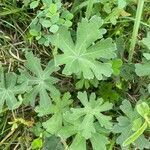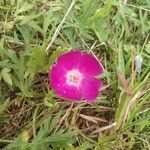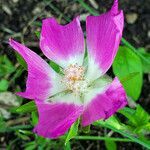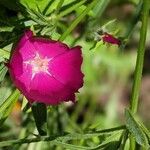Stems ascending, to 10(–20) dm; herbage rough-pubescent to hirsute, often with simple hairs, those around the base of the cal stiff, spreading, 1–3 mm; lvs orbicular in general outline, deeply 5–7-lobed, the principal divisions oblanceolate to cuneate-obovate, lobed or incised; stipules mostly 5–15 mm; peduncles (pedicels) mainly axillary, 3–10 cm, 1-fld; bractlets lanceolate or linear, 8–17 mm; gynodioecious; cal-lobes lanceolate or lance-ovate, 9–16 mm, with separate, loose, free tips 4.5–10+ mm, pet red or purple with a white basal spot, 19–32 mm (9–20 in functionally pistillate fls); mature carpels strongly rugose, strigose at least distally; 2n mostly=30, 60. Open places, esp. dry upland prairies; Ill. to s. Minn. and w. Wyo., s. to Ark., Tex., and n. Mex.; adventive in Pa. May–Oct. Our plants belong to the northern var. involucrata, as here described.
A low growing sprawling plant. It keeps growing from year to year. It grows 15-30 cm high and spreads 30-60 cm wide. The root is large and tapers. The stems lie along the ground. They are hairy and 15 cm long. The leaves have 3 to 7 lobes. The leaves are 2.5-5 cm long. The flowers are red or purple. They are on long erect stems.




